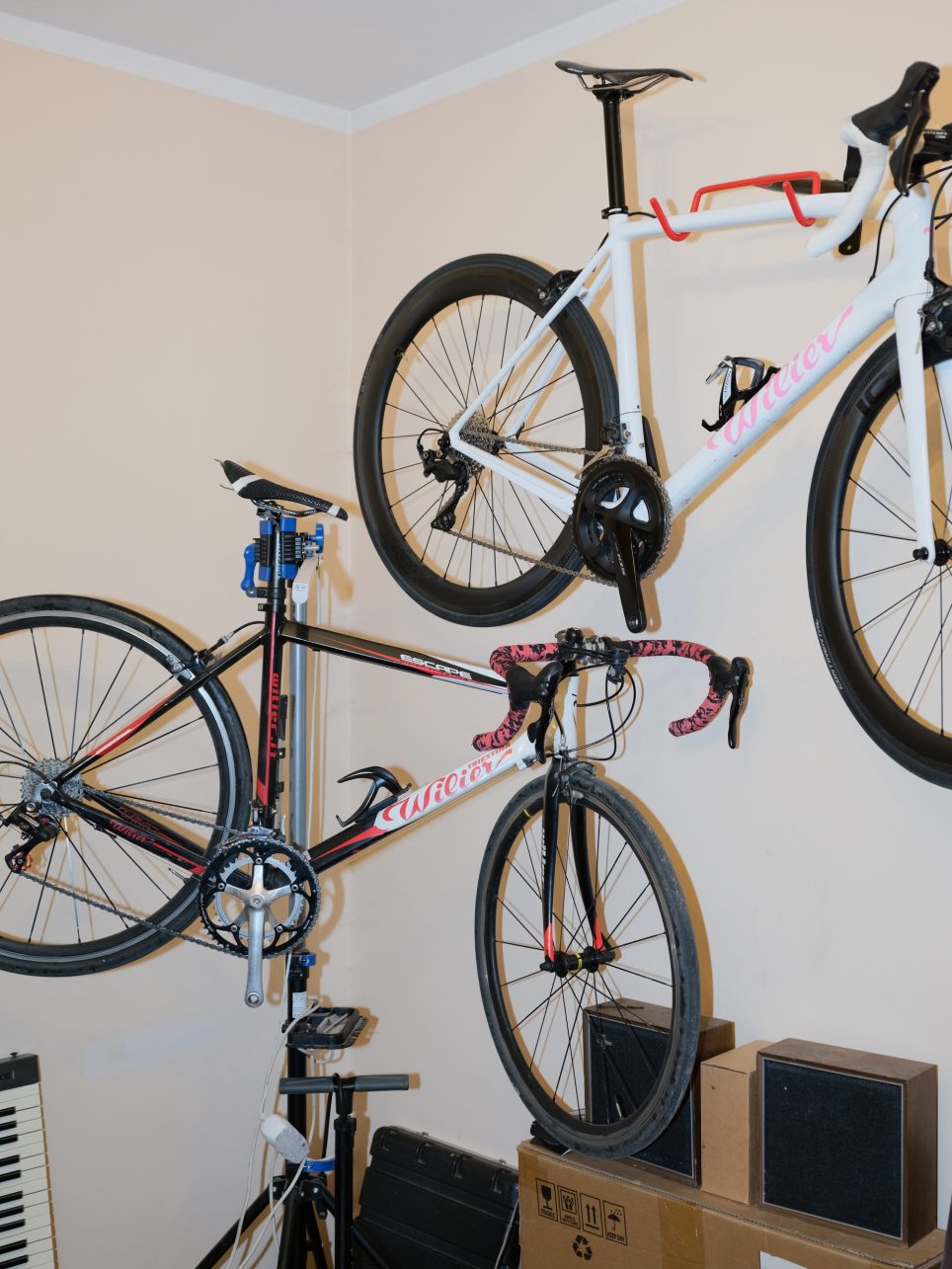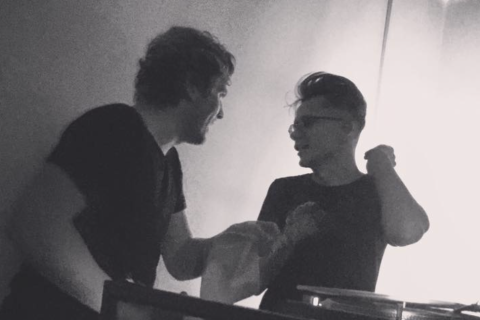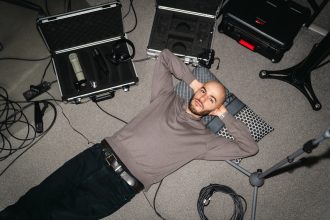“Cycling a 100 km feels like partying: sweat, colorful synthetic clothes, teammates centimeters away, a lot of trust, you’re constantly switching places and talking – it’s just like at a rave,” Aurimas Šabasevičius laughs as we discuss his collection of music-making machines and move on to the bicycles that are hanging right there on the living-room wall.
Acid dance
This architect spends a lot more time cycling than partying – last year alone he cycled 8,000 kilometers, this year already about 1,500, and after the interview, he began cycling to Wales. But you can talk to Aurimas about bicycles in person, if you meet him in the Kaunas area. This time, we focus on the music he creates and performs but never releases. Its nature and purpose are already encoded in the pseudonym Assassid – a fusion of the words acid and assassin.

The sounds of analogue synthesizers warm you up and tickle your ears and the lower abdomen, while the ever-echoing loops invite you to join in a dance worthy of ancient rituals. Pure composition and sound design methods with a steady yet non-trivial rhythm and waves that either gently knock at you or fiercely batter, draw you in. This is how we would attempt to explain the nature and impact of Assassid’s music to those who have not yet heard this artist live.
If you’re eager to get at least a small taste of the sound we’ll be discussing over the next few pages, look up Petras Baronas’ YouTube video Assassid Tense 2010 vs short film The Morning. In it, Aurimas’ dark and sonically archaic yet by no means outdated music ironically complements the futuristic visuals of Shanghai. You can find some more recordings – more drafts than finished pieces – on Soundcloud. On it, the artist uses an avatar featuring Arabic motifs. The analogy between desert storms and sharp-edged electronics is easy to hear – so much so that Aurimas and I almost simultaneously mention the name of the late British musician Muslimgauze.

The curse of the car thief
Aurimas began accumulating his raver capital back in the last millennium, while living in Jonava. By the time he graduated from high school, he had already played guitar in a rock band and tried his hand at DJing. He shares an incredible story of music import – an acquaintance who had gone to Germany to rob cars returned with a real treasure found in a car stereo: a metal SONY cassette filled with the acidic sounds of Plastikman (aka Richie Hawtin, who played in Vilnius this March. The thirty-year wait filled a club full of veterans, ed.). Aurimas still appreciates this format today, saying he never felt much sentiment for the crackle of vinyl, “I like the hiss of a cassette, I feel the depth and the background behind the sound.”
With a high school diploma in his teeth, Aurimas decided to move to Kaunas and found himself in one of the best possible places for alternative youth at the end of the 20th century on Owl Hill. After meeting the like-minded people in “stepžūkis” (currently Faculty of Arts and Education of Kaunas College), he soon went down the hill to the alternative center of Kaunas and the Old Town. He witnessed the parties at the Pakalnė canteen and in the basement of the Kaunas faculty of his future alma mater, Vilnius Academy of Arts, which have already been described in more detail in our magazine, and he made his debut in Antis Cafe which used to be located under the Architects’ House at 22 Vilniaus Street. Here, Darius Čiuta’s interior design was superior to the meagre DJ equipment, but it was possible to earn fifty litas for changing the tracks, and the artsy people who gathered here were of the finest quality.
Over Aurimas’ three decades in Kaunas, many nightlife trends and fashionable venues have come and gone. One of them, the decaying Šilelis Palace of Culture, a reminder of the psychedelic Terra X period, is right next to his apartment on the slopes of Žaliakalnis, and behind it is the former Kaunas Radio Factory. Today, almost all of it has been turned into lofts, and a dozen years ago the former workshops and offices of the factory were occupied by all sorts of small businesses. And artists.
Aurimas and his friends secured a studio in the former factory, driven by a desire to rebel against Kaunas’ alternative party organizers, who had strayed onto more conformist paths and started playing rather dull music. To avoid issues with the property owners, they combined raves and DJing with art and artists: something that no longer surprises anyone today. Step Service crew had been preparing for its first event Artefaktai for a couple of months – just as the last big economic crisis was hitting, Aurimas lost his job as an architect, so he invested all his efforts in preparing the premises, the set design, lighting, and other elements. After a highly successful debut, Artefaktai also took place at the VDU Kaunas Botanical Garden, though on a smaller scale. But that’s often the price of being avant-garde and refusing to cater to the masses – you won’t be the most popular, and you won’t make a living from a hobby.
Going against the grain
This is a good place to clarify that the acid sound we’re discussing here was first spat out by a Japanese synthesizer, the Roland TB-303, released in 1981, which was intended to replace the bass guitar. The latter didn’t happen, the synthesizer wasn’t popular among bands because of its unconvincing sound, but it did end up in the hands of Chicago producers, giving birth to the acid house music beloved globally, and from it to the much fiercer, but also very effective, acid techno.
We didn’t find a Roland TB-303 in Aurimas’ apartment; these vintage synthesizers are prohibitively expensive, but there are clones of them, made by engineers at Behringer, for example. In general, the architect does not have as many machines as one would expect from a middle-aged man with expensive hobbies. Apparently, the architect’s natural minimalism, the desire to create as much as possible with as little as possible, and his clear mind win out.

When asked how he settled on acid techno, Aurimas pauses – there wasn’t really a conscious decision that it had to be this way and no other. He listens to a wide variety of styles, sometimes even imagining that he himself created certain tracks – mentally deconstructing them – while his experimental drawer is filled with fragments of various started-but-unfinished musical narratives. “I liked acid in the ‘90s when it first emerged, then I kind of forgot about it for a while. But around 2005, it felt like it was making a comeback – even in pop music, you could hear acid motifs in tracks by artists like Britney Spears,” he recalls. He adds that, most likely, he naturally gravitated toward purity in music, seeking a counterbalance to the overly popularized minimal sound.
When Aurimas moved to his current home, he dreamt of playing the guitar as he did when he was younger, but realised it wasn’t his instrument, even the fingers weren’t the right length, so he never went back to the strings again. The analogue sound he creates is dark, deep, but intimate, born here and now when the machines are switched on, changing even with temperature. It seems difficult to squeeze it into a recording. At the same time, the question is whether it is necessary to record everything. Does this world need another album, another tape? After all, what defines a musician, much more than any fragment of time, is his talent for performing his work here and now. Moreover, the specificity of Assassid’s music and the timing and setting of his performances create the opportunity for each listener to experience a completely individual analogue acid attack.
Where to catch Assassid live?
As we’ve mentioned, Aurimas’ first encounter with performing music was back in school. It took some time before his second debut on stage. The festival Tundra, which left an indelible mark on the memory of the middle generation, along with smaller gatherings of a similar nature and a few club events, make up Assassid’s résumé; on the other hand, it doesn’t contain less honourable tracks that would embarrass him today. When he started playing nearly 20 years ago, there were only a handful like him, and a live performance was often the highlight of a night otherwise dominated by DJs. Nowadays, there are more opportunities, making event lineups more diverse, although the alternative electronic music scene remains relatively small.
Assassid’s recent performances include last year’s live show at the capital’s alternative elite spot Draugų vardai, a visit to Uno Club that operates in the former Fluxus Ministry or Lituanica factory, and Hydra gathering last summer.
“I deliberately chose nine a.m. so I could wake up and come as if to work. When my mind is clear, I can play with exceptional quality, even though my music might not be the most suitable for that time of day,” he recalls with a smile, thinking back to the morning by the Kaunas Lagoon.
And it seems to us that there is already a need for daytime raves with stronger music. After all, the ranks of party veterans over 40 are growing; they don’t want to put their sneakers away yet, but it’s too hard to wait until 3 a.m. for their favorite artist. Let’s put the wish out into the universe, and in the meantime, let’s look for Aurimas in Strava. Once you’ve caught up with him on the highway and listened to the mix of spinning pedals and the heartbeat in the second zone, you can almost feel like you’re at a rave.





